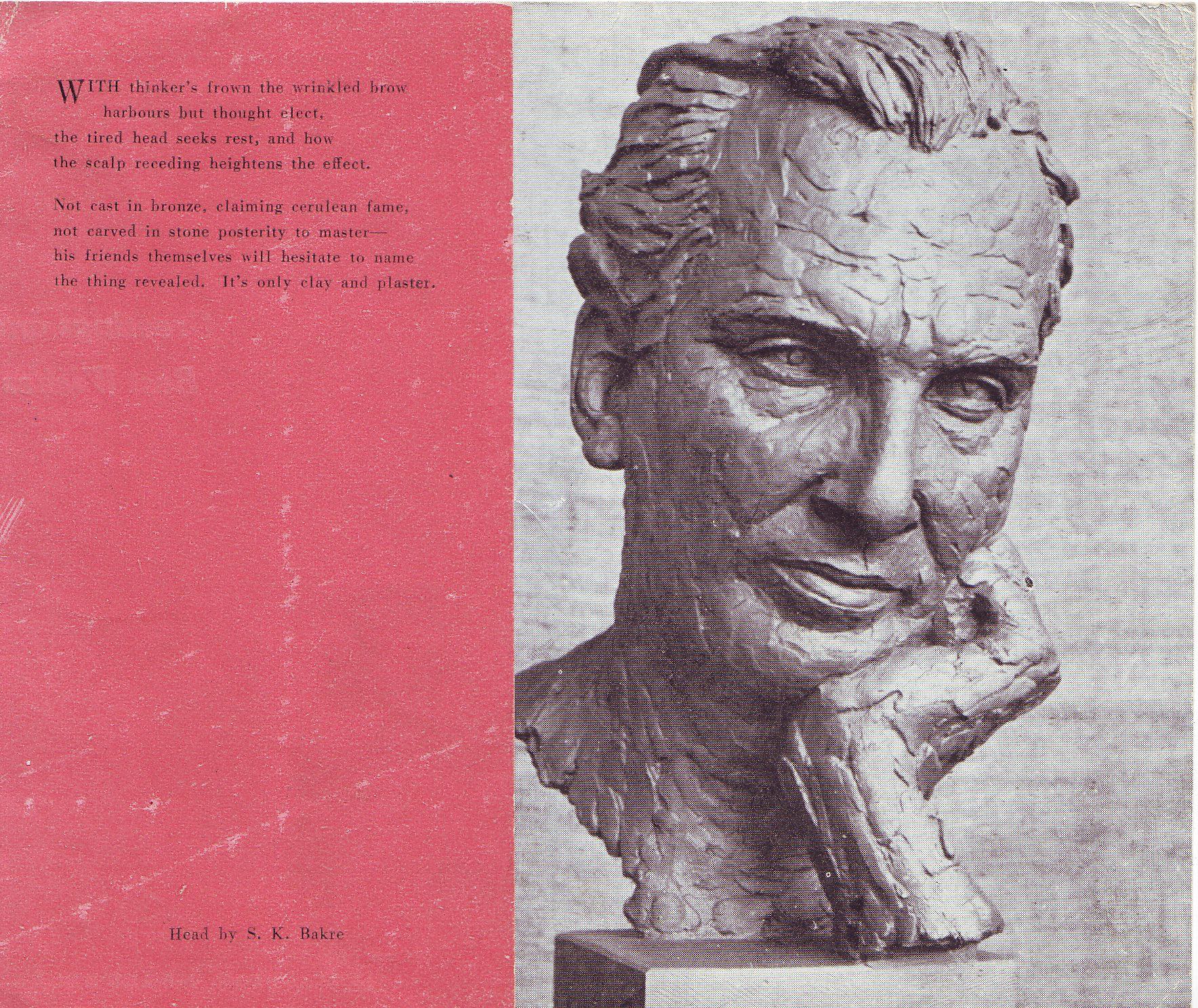Archive
Picture of Rudi von Leyden’ s Bust by Sadanand K. Bakre
- Photograph
Picture of Rudi von Leyden’ s Bust by Sadanand K. Bakre
Word Count: 11
- Rudolf von Leyden
- 1949
- 1950
Greetings Card: Photograph on Paper
Sculpture: Clay/Plaster 1949; Bronze 1950Jaiji Mansion, Merewether Road, Colaba, Bombay (now Mumbai).
- Mumbai (IN)
The picture of the previously lost and recently located sculpture by Sadanand K. Bakre reflects the relationship between the artist Bakre and the art critic Rudi von Leyden.
Word Count: 28

Bakre’s clay bust featured on Leyden’s greetings card, 1949 (© Private Archive James von Leyden, Lewes. All Rights Reserved). 
Press clipping with historic photo of young Bakre working on the clay bust while Leyden sits as a model, late 1940s (Maddox, Georgina. “In Retrospect.” Indian Express, 8 November 2002, p. 8. © Indian Express. Reprinted in Singh 2013, 276; Image courtesy: Delhi Art Gallery). 
Press clipping from a Marathi Newspaper showing Bakre’s bust of Leyden, 1997 (Reprinted in Singh 2013, 276; Image courtesy: Delhi Art Gallery). 
S.K. Bakre, Head, 1950, Bronze. Exhibited at the National Gallery of Modern Art, 2018 (© Creative Commons, Photo: Ashok Bhatia 2018). Bhagwat, Nalini. “Life and Art of Sadanand Bakre. Feature.” art etc. news & views, January 2012, www.artnewsnviews.com/view-article.php?article=life-and-art-of-sadanand-bakre&iid=29&articleid=806. Accessed 31 March 2021.
Bhagwat, Nalini, and Ratan Parimoo. “Progressive Artists Group of Bombay: An Overview. The Spirit of Late 1940s and Early 1950s.” art etc. news & views, January 2012, www.artnewsnviews.com/view-article.php?article=progressive-artists-group-of-bombay-an-overview&iid=29&articleid=800ws. Accessed 31 March 2021.
Bhatia, Ashok. “A walk through the National Gallery of Modern Art in New Delhi, India: Part 3 of 3.” 10 May 2018, ASHOKBHATIA: Of Management, Wodehouse, Movies and things in general!, ashokbhatia.wordpress.com/2018/05/10/a-walk-through-the-national-gallery-of-modern-art-in-new-delhi-india-part-3-of-3/#respond. Accessed 5 April 2021.
Chatterji, R. “Two Art Exhibitions in Bombay.” The Times of India, 10 July 1949, p. 10.
Continuum: Progressive Artists’ Group, edited by Kishore Singh, exh. cat. Delhi Art Gallery, New Delhi, 2011.
Franz, Margit. “Exile meets Avantgarde: ExilantInnen-Kunstnetzwerke in Bombay.” Going East – Going South. Österreichisches Exil in Asien und Afrika, edited by Margit Franz and Heimo Halbrainer, CLIO, 2014, pp. 403–431. Academia, www.academia.edu/49079321/Exile_meets_Avantgarde_ExilantInnen_Kunstnetzwerke_in_Bombay. Accessed 16 June 2021.
Franz, Margit. Gateway India. Deutschsprachiges Exil in Indien zwischen britischer Kolonialherrschaft, Maharadschas und Gandhi. CLIO, 2015.
Franz, Margit. “From Dinner Parties to Galleries: The Langhammer-Leyden-Schlesinger Circle in Bombay – 1940s through the 1950s.” Arrival Cities. Migrating Artists and New Metropolitan Topographies in the 20th Century, edited by Burcu Dogramaci et al., Leuven University Press, 2020, pp. 73–90. Project Muse, doi: 10.1353/book.77990. Accessed 30 March 2021.
Ganguly, Nanak. “Progressive Art Group Show: The Moderns. Revisited.” art etc. news & views, February 2012, www.artnewsnviews.com/view-article.php?article=progressive-art-group-show-the-moderns&iid=30&articleid=837. Accessed 5 April 2021.
[Leyden, Rudolf von]. “Artists’ Exhibition In Bombay ‘DISTINCT GROUP’.” The Times of India, 9 July 1949, p. 8.
[Leyden, Rudolf von]. “Bombay Sculptorʼs Exhibition. Mr. Sadanand Bakre.” The Times of India, 5 March 1951, p. 3.
Maddox, Georgina. “In Retrospect.” Indian Express, 8 November 2002, p. 8.
Mumbai Modern: Progressive Artistsʼ Group 1947–2013, edited by Kishore Singh, Delhi Art Gallery (DAG), New Delhi, 2013.
Saffronart. “Remembering Sadanand Bakre.” 2008, Saffronart, www.saffronart.com/sitepages/ArticleDetails.aspx?Articleid=669&PageNo=1. Accessed 31 March 2021.
Singh, Kishore. Sadanand Krishnaji Bakre: A Talent Too Many (DAG, Artists’ Series). Delhi Art Gallery, 2011.
Word Count: 343
Private Archive James von Leyden, Lewes.
Private Archive Margit Franz, Sinabelkirchen.Word Count: 11
- Rudolf von Leyden
- Bombay
- Margit Franz. "Picture of Rudi von Leyden’ s Bust by Sadanand K. Bakre." METROMOD Archive, 2021, https://archive.metromod.net/viewer.p/69/2951/object/5140-12032178, last modified: 14-09-2021.
-
Rudolf von LeydenGeologistAdvertisement SpecialistJournalistArt CriticArt CollectorCartoonistBombay
The advertisement expert, Rudolf von Leyden, became a major art critic and art historian in Bombay in the 1940s, advocating an urgent need for modernism in art in post-colonial India.
Word Count: 30
Emanuel SchlesingerFactory OwnerTechnical DirectorArt CollectorArt CriticBombayThe art collector Schlesinger provided primarily financial aid by creating working opportunities for young artists in post-independence Bombay, and initiated the corporate culture of buying art.
Word Count: 26
Charles PetrasJournalistDirectorLanguage TeacherWriterTheatre MakerArt ManagerTranslatorBombayCharles Petras was the founder and director of the international cultural centre Institute of Foreign Languages, an avant-garde theatre director and a very active promoter of international understanding and world peace.
Word Count: 31
Bombay Art SocietyAssociationBombayOne of the oldest art societies in India founded by colonial rulers, Bombay Art Society showcased art students and professional artists from all over India, including the Progressive Artists of Bombay.
Word Count: 31
Jehangir Art GalleryArt GalleryAuditorium HallLibraryBombayEfforts to create spaces for the democratic presentation, discussion and reflection of art in Bombay after independence led to the establishment of the Jehangir Art Gallery in 1952.
Word Count: 27
Iconic Photo of the Progressive Artists’ Group and Their AssociatesPhotographBombayThere are two versions of the PAG photo at the opening of M.F. Husain's first solo exhibition in 1950 (published in 1996 and 2003) and two narratives about the opening.
Word Count: 28
Open Studio Evenings by Käthe and Walter LanghammerSalonBombayThe painter Walter Langhammer and his wife Käthe built an informal infrastructure to promote local avant-garde artists and regularly invited them to Open Studio Evenings at their studio.
Word Count: 29